Critical Success Factors and Project Management Life Cycle Processes
VerifiedAdded on 2023/03/31
|15
|2516
|349
Essay
AI Summary
This essay provides an overview of project management, highlighting the critical factors that contribute to project success, such as team commitment, effective communication, resource allocation, leadership, and smart planning. It delves into the concept of project management, emphasizing its role in bringing about desired change within organizations. The essay outlines the features of a successful project, including timely completion, budget adherence, stakeholder satisfaction, and clear objectives. Furthermore, it details the five Project Management Life Cycle (PMLC) processes: initiation, planning, implementation (execution), monitoring and controlling, and termination (closure). The importance of the triple constraint—time, scope, and cost—is discussed, along with techniques for effective time management, such as ABC analysis and Pareto analysis. The essay concludes by reinforcing the significance of these elements in achieving project success and meeting stakeholder expectations. Desklib provides access to similar solved assignments and past papers.

Running Head: PROJECT SUCCESS 1
PROJECT MANAGEMENT
STUDENT’S NAME
COURSE
UNIVERSITY
DATE
PROJECT MANAGEMENT
STUDENT’S NAME
COURSE
UNIVERSITY
DATE
Paraphrase This Document
Need a fresh take? Get an instant paraphrase of this document with our AI Paraphraser
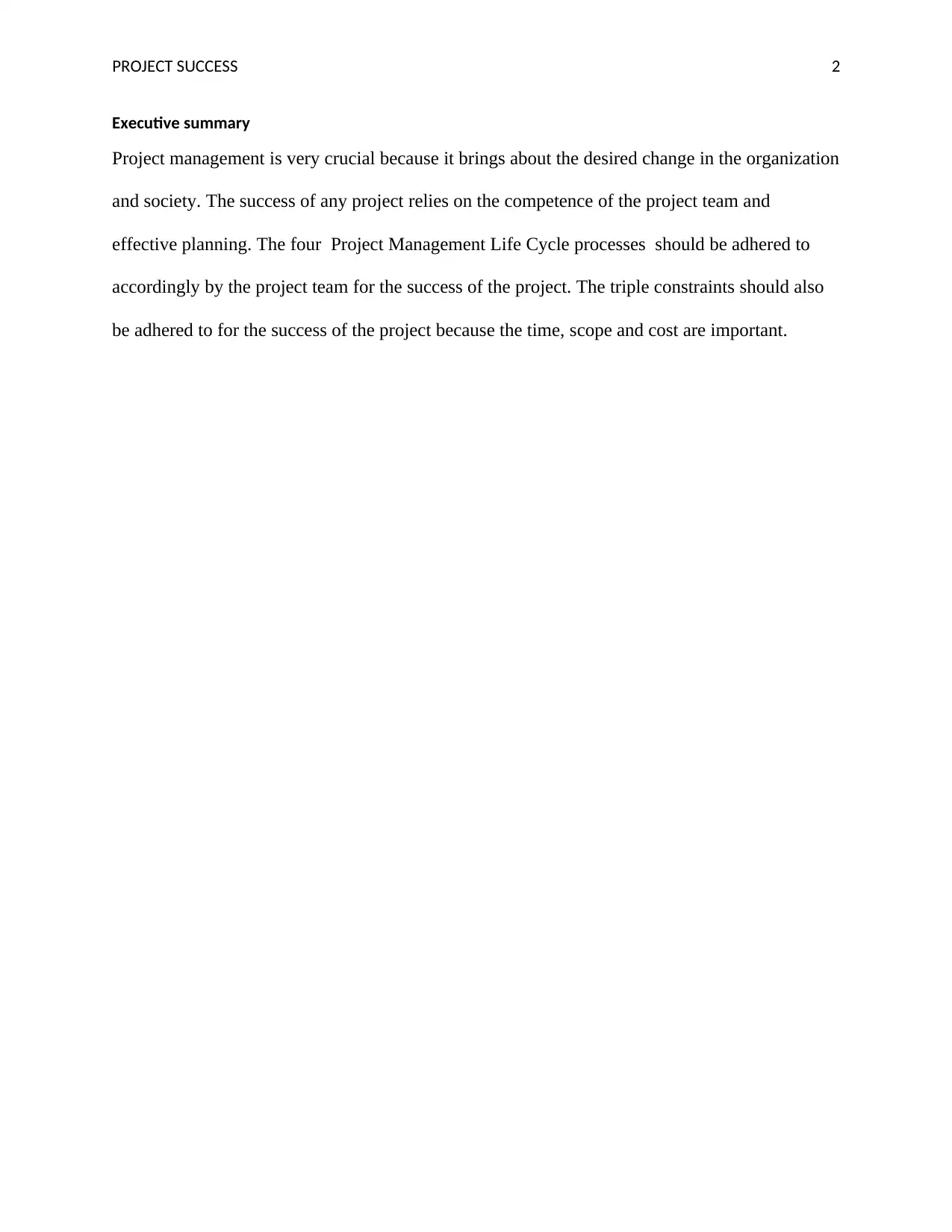
PROJECT SUCCESS 2
Executive summary
Project management is very crucial because it brings about the desired change in the organization
and society. The success of any project relies on the competence of the project team and
effective planning. The four Project Management Life Cycle processes should be adhered to
accordingly by the project team for the success of the project. The triple constraints should also
be adhered to for the success of the project because the time, scope and cost are important.
Executive summary
Project management is very crucial because it brings about the desired change in the organization
and society. The success of any project relies on the competence of the project team and
effective planning. The four Project Management Life Cycle processes should be adhered to
accordingly by the project team for the success of the project. The triple constraints should also
be adhered to for the success of the project because the time, scope and cost are important.
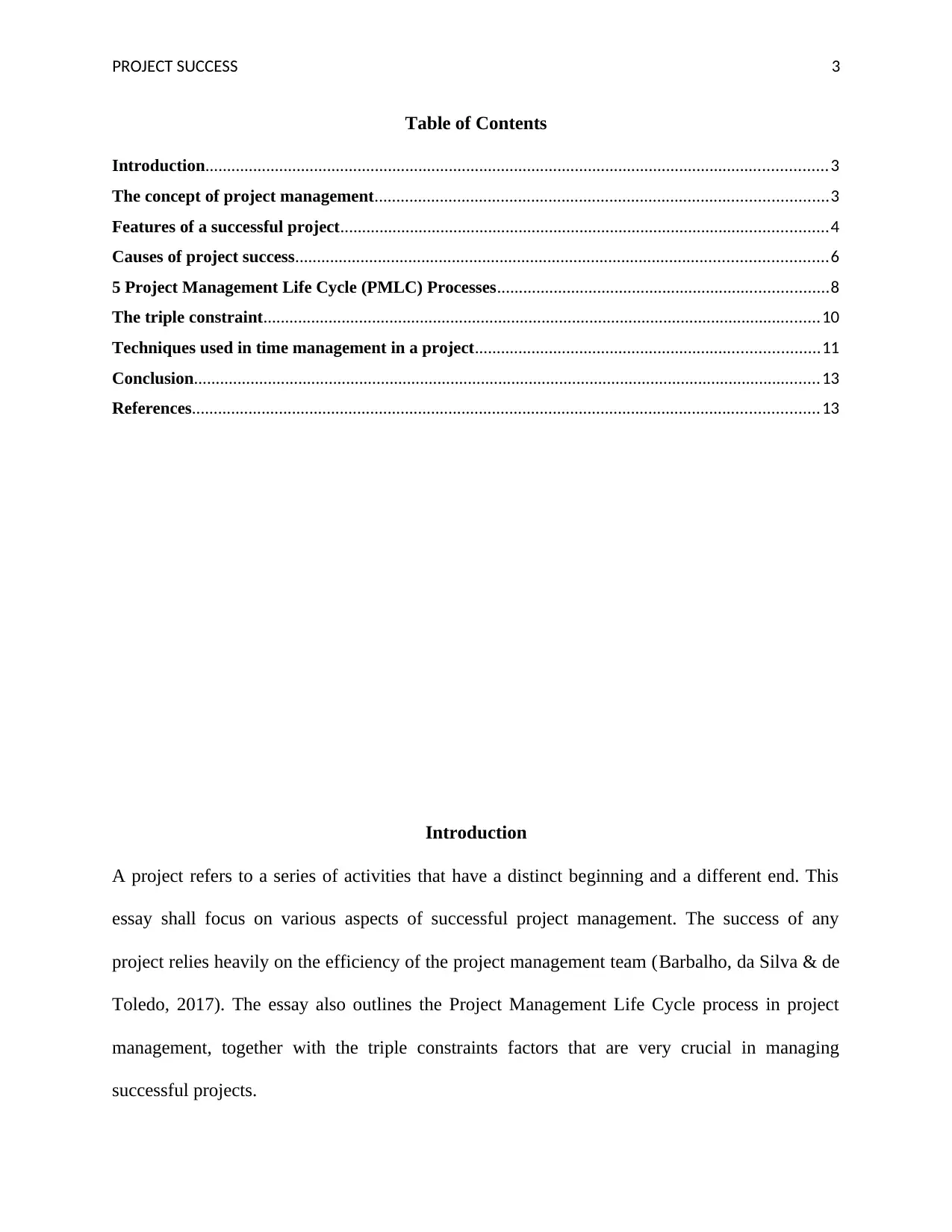
PROJECT SUCCESS 3
Table of Contents
Introduction...............................................................................................................................................3
The concept of project management........................................................................................................3
Features of a successful project................................................................................................................4
Causes of project success..........................................................................................................................6
5 Project Management Life Cycle (PMLC) Processes............................................................................8
The triple constraint................................................................................................................................10
Techniques used in time management in a project...............................................................................11
Conclusion................................................................................................................................................13
References................................................................................................................................................13
Introduction
A project refers to a series of activities that have a distinct beginning and a different end. This
essay shall focus on various aspects of successful project management. The success of any
project relies heavily on the efficiency of the project management team (Barbalho, da Silva & de
Toledo, 2017). The essay also outlines the Project Management Life Cycle process in project
management, together with the triple constraints factors that are very crucial in managing
successful projects.
Table of Contents
Introduction...............................................................................................................................................3
The concept of project management........................................................................................................3
Features of a successful project................................................................................................................4
Causes of project success..........................................................................................................................6
5 Project Management Life Cycle (PMLC) Processes............................................................................8
The triple constraint................................................................................................................................10
Techniques used in time management in a project...............................................................................11
Conclusion................................................................................................................................................13
References................................................................................................................................................13
Introduction
A project refers to a series of activities that have a distinct beginning and a different end. This
essay shall focus on various aspects of successful project management. The success of any
project relies heavily on the efficiency of the project management team (Barbalho, da Silva & de
Toledo, 2017). The essay also outlines the Project Management Life Cycle process in project
management, together with the triple constraints factors that are very crucial in managing
successful projects.
⊘ This is a preview!⊘
Do you want full access?
Subscribe today to unlock all pages.

Trusted by 1+ million students worldwide
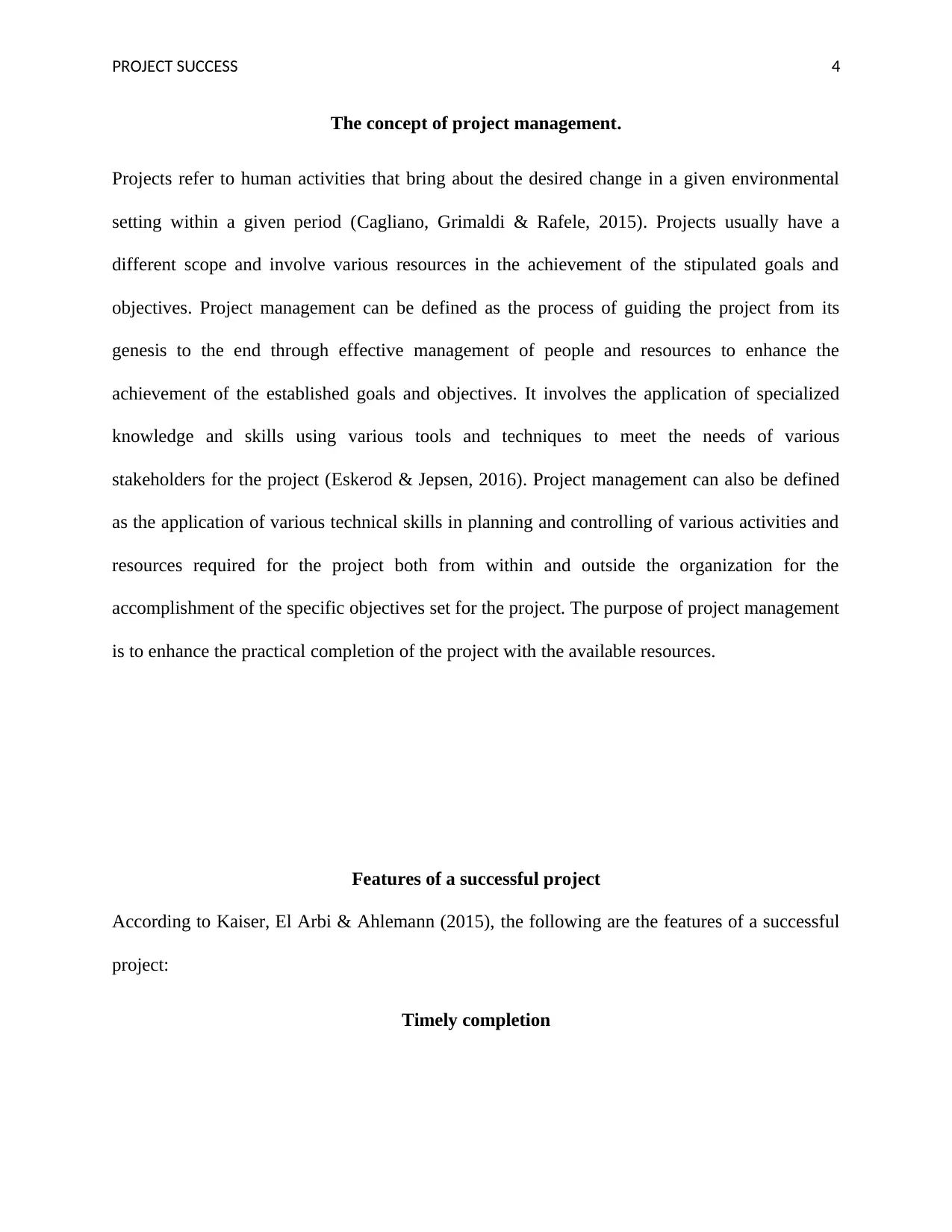
PROJECT SUCCESS 4
The concept of project management.
Projects refer to human activities that bring about the desired change in a given environmental
setting within a given period (Cagliano, Grimaldi & Rafele, 2015). Projects usually have a
different scope and involve various resources in the achievement of the stipulated goals and
objectives. Project management can be defined as the process of guiding the project from its
genesis to the end through effective management of people and resources to enhance the
achievement of the established goals and objectives. It involves the application of specialized
knowledge and skills using various tools and techniques to meet the needs of various
stakeholders for the project (Eskerod & Jepsen, 2016). Project management can also be defined
as the application of various technical skills in planning and controlling of various activities and
resources required for the project both from within and outside the organization for the
accomplishment of the specific objectives set for the project. The purpose of project management
is to enhance the practical completion of the project with the available resources.
Features of a successful project
According to Kaiser, El Arbi & Ahlemann (2015), the following are the features of a successful
project:
Timely completion
The concept of project management.
Projects refer to human activities that bring about the desired change in a given environmental
setting within a given period (Cagliano, Grimaldi & Rafele, 2015). Projects usually have a
different scope and involve various resources in the achievement of the stipulated goals and
objectives. Project management can be defined as the process of guiding the project from its
genesis to the end through effective management of people and resources to enhance the
achievement of the established goals and objectives. It involves the application of specialized
knowledge and skills using various tools and techniques to meet the needs of various
stakeholders for the project (Eskerod & Jepsen, 2016). Project management can also be defined
as the application of various technical skills in planning and controlling of various activities and
resources required for the project both from within and outside the organization for the
accomplishment of the specific objectives set for the project. The purpose of project management
is to enhance the practical completion of the project with the available resources.
Features of a successful project
According to Kaiser, El Arbi & Ahlemann (2015), the following are the features of a successful
project:
Timely completion
Paraphrase This Document
Need a fresh take? Get an instant paraphrase of this document with our AI Paraphraser
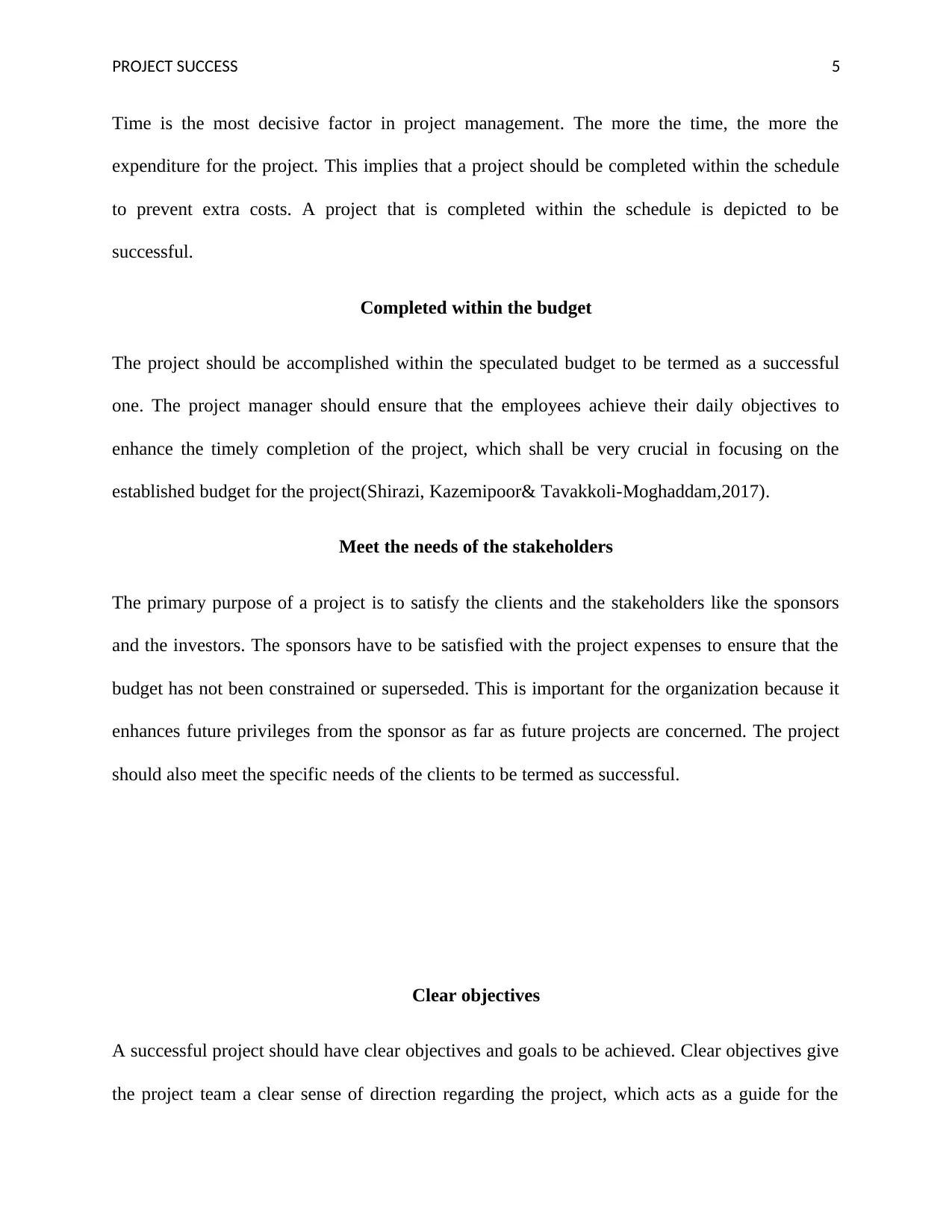
PROJECT SUCCESS 5
Time is the most decisive factor in project management. The more the time, the more the
expenditure for the project. This implies that a project should be completed within the schedule
to prevent extra costs. A project that is completed within the schedule is depicted to be
successful.
Completed within the budget
The project should be accomplished within the speculated budget to be termed as a successful
one. The project manager should ensure that the employees achieve their daily objectives to
enhance the timely completion of the project, which shall be very crucial in focusing on the
established budget for the project(Shirazi, Kazemipoor& Tavakkoli-Moghaddam,2017).
Meet the needs of the stakeholders
The primary purpose of a project is to satisfy the clients and the stakeholders like the sponsors
and the investors. The sponsors have to be satisfied with the project expenses to ensure that the
budget has not been constrained or superseded. This is important for the organization because it
enhances future privileges from the sponsor as far as future projects are concerned. The project
should also meet the specific needs of the clients to be termed as successful.
Clear objectives
A successful project should have clear objectives and goals to be achieved. Clear objectives give
the project team a clear sense of direction regarding the project, which acts as a guide for the
Time is the most decisive factor in project management. The more the time, the more the
expenditure for the project. This implies that a project should be completed within the schedule
to prevent extra costs. A project that is completed within the schedule is depicted to be
successful.
Completed within the budget
The project should be accomplished within the speculated budget to be termed as a successful
one. The project manager should ensure that the employees achieve their daily objectives to
enhance the timely completion of the project, which shall be very crucial in focusing on the
established budget for the project(Shirazi, Kazemipoor& Tavakkoli-Moghaddam,2017).
Meet the needs of the stakeholders
The primary purpose of a project is to satisfy the clients and the stakeholders like the sponsors
and the investors. The sponsors have to be satisfied with the project expenses to ensure that the
budget has not been constrained or superseded. This is important for the organization because it
enhances future privileges from the sponsor as far as future projects are concerned. The project
should also meet the specific needs of the clients to be termed as successful.
Clear objectives
A successful project should have clear objectives and goals to be achieved. Clear objectives give
the project team a clear sense of direction regarding the project, which acts as a guide for the
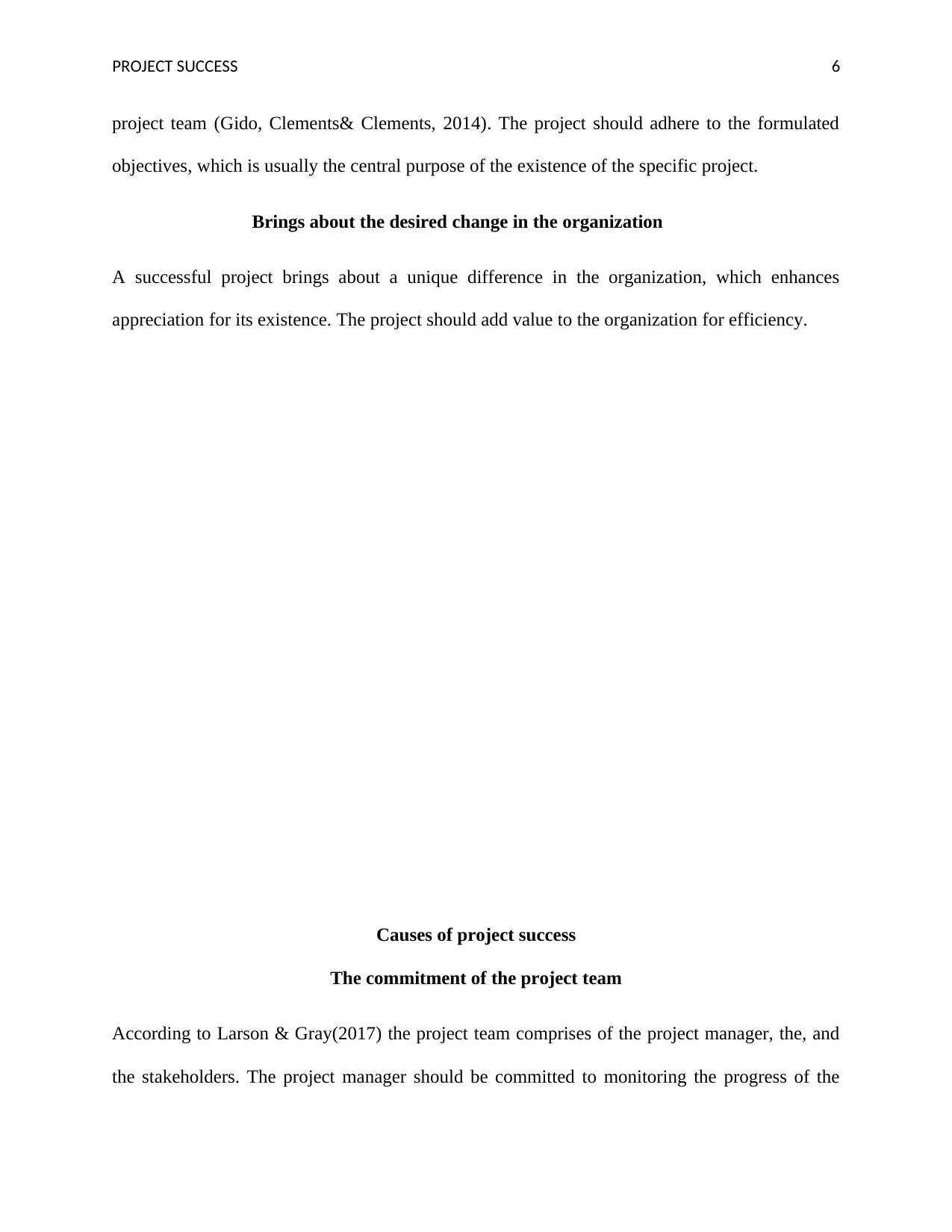
PROJECT SUCCESS 6
project team (Gido, Clements& Clements, 2014). The project should adhere to the formulated
objectives, which is usually the central purpose of the existence of the specific project.
Brings about the desired change in the organization
A successful project brings about a unique difference in the organization, which enhances
appreciation for its existence. The project should add value to the organization for efficiency.
Causes of project success
The commitment of the project team
According to Larson & Gray(2017) the project team comprises of the project manager, the, and
the stakeholders. The project manager should be committed to monitoring the progress of the
project team (Gido, Clements& Clements, 2014). The project should adhere to the formulated
objectives, which is usually the central purpose of the existence of the specific project.
Brings about the desired change in the organization
A successful project brings about a unique difference in the organization, which enhances
appreciation for its existence. The project should add value to the organization for efficiency.
Causes of project success
The commitment of the project team
According to Larson & Gray(2017) the project team comprises of the project manager, the, and
the stakeholders. The project manager should be committed to monitoring the progress of the
⊘ This is a preview!⊘
Do you want full access?
Subscribe today to unlock all pages.

Trusted by 1+ million students worldwide
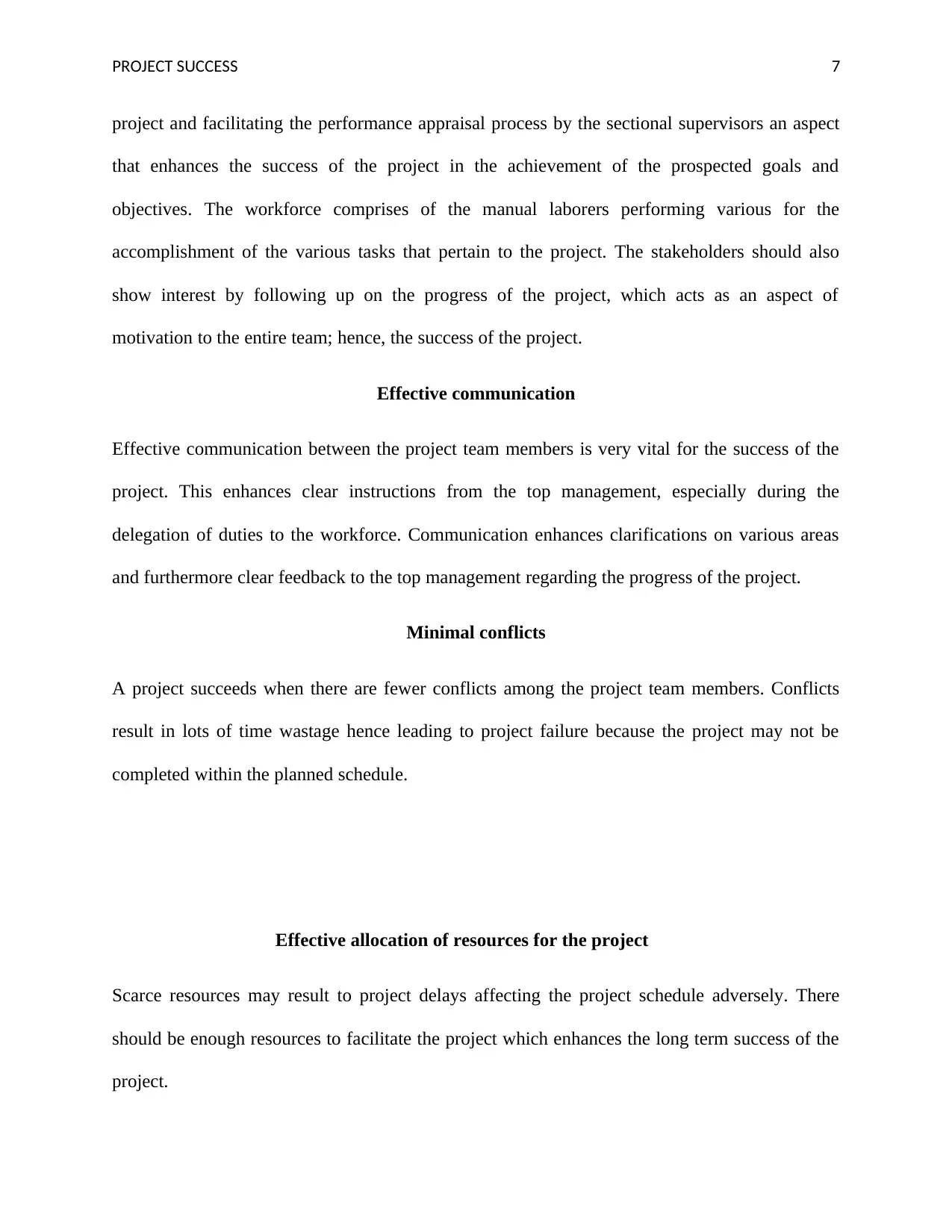
PROJECT SUCCESS 7
project and facilitating the performance appraisal process by the sectional supervisors an aspect
that enhances the success of the project in the achievement of the prospected goals and
objectives. The workforce comprises of the manual laborers performing various for the
accomplishment of the various tasks that pertain to the project. The stakeholders should also
show interest by following up on the progress of the project, which acts as an aspect of
motivation to the entire team; hence, the success of the project.
Effective communication
Effective communication between the project team members is very vital for the success of the
project. This enhances clear instructions from the top management, especially during the
delegation of duties to the workforce. Communication enhances clarifications on various areas
and furthermore clear feedback to the top management regarding the progress of the project.
Minimal conflicts
A project succeeds when there are fewer conflicts among the project team members. Conflicts
result in lots of time wastage hence leading to project failure because the project may not be
completed within the planned schedule.
Effective allocation of resources for the project
Scarce resources may result to project delays affecting the project schedule adversely. There
should be enough resources to facilitate the project which enhances the long term success of the
project.
project and facilitating the performance appraisal process by the sectional supervisors an aspect
that enhances the success of the project in the achievement of the prospected goals and
objectives. The workforce comprises of the manual laborers performing various for the
accomplishment of the various tasks that pertain to the project. The stakeholders should also
show interest by following up on the progress of the project, which acts as an aspect of
motivation to the entire team; hence, the success of the project.
Effective communication
Effective communication between the project team members is very vital for the success of the
project. This enhances clear instructions from the top management, especially during the
delegation of duties to the workforce. Communication enhances clarifications on various areas
and furthermore clear feedback to the top management regarding the progress of the project.
Minimal conflicts
A project succeeds when there are fewer conflicts among the project team members. Conflicts
result in lots of time wastage hence leading to project failure because the project may not be
completed within the planned schedule.
Effective allocation of resources for the project
Scarce resources may result to project delays affecting the project schedule adversely. There
should be enough resources to facilitate the project which enhances the long term success of the
project.
Paraphrase This Document
Need a fresh take? Get an instant paraphrase of this document with our AI Paraphraser
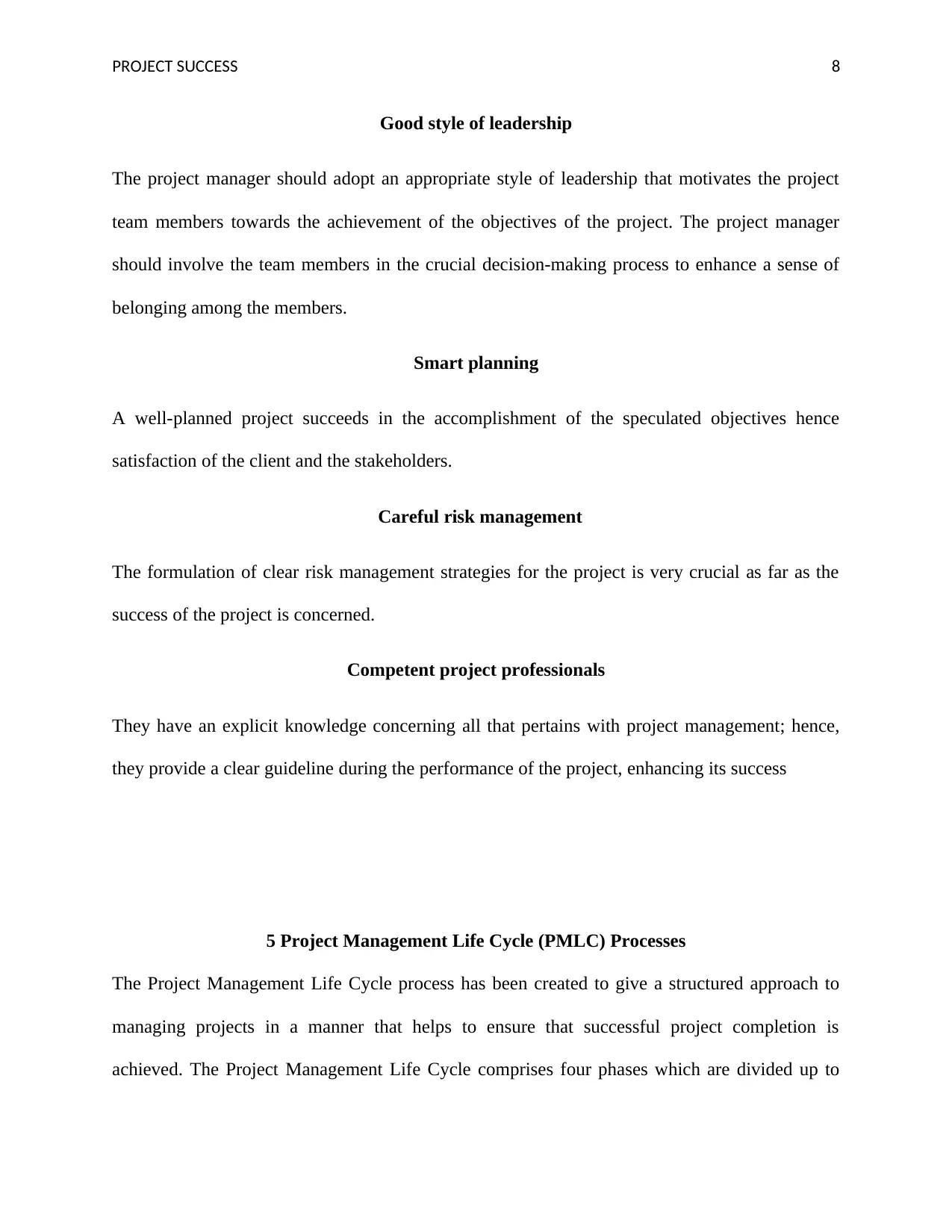
PROJECT SUCCESS 8
Good style of leadership
The project manager should adopt an appropriate style of leadership that motivates the project
team members towards the achievement of the objectives of the project. The project manager
should involve the team members in the crucial decision-making process to enhance a sense of
belonging among the members.
Smart planning
A well-planned project succeeds in the accomplishment of the speculated objectives hence
satisfaction of the client and the stakeholders.
Careful risk management
The formulation of clear risk management strategies for the project is very crucial as far as the
success of the project is concerned.
Competent project professionals
They have an explicit knowledge concerning all that pertains with project management; hence,
they provide a clear guideline during the performance of the project, enhancing its success
5 Project Management Life Cycle (PMLC) Processes
The Project Management Life Cycle process has been created to give a structured approach to
managing projects in a manner that helps to ensure that successful project completion is
achieved. The Project Management Life Cycle comprises four phases which are divided up to
Good style of leadership
The project manager should adopt an appropriate style of leadership that motivates the project
team members towards the achievement of the objectives of the project. The project manager
should involve the team members in the crucial decision-making process to enhance a sense of
belonging among the members.
Smart planning
A well-planned project succeeds in the accomplishment of the speculated objectives hence
satisfaction of the client and the stakeholders.
Careful risk management
The formulation of clear risk management strategies for the project is very crucial as far as the
success of the project is concerned.
Competent project professionals
They have an explicit knowledge concerning all that pertains with project management; hence,
they provide a clear guideline during the performance of the project, enhancing its success
5 Project Management Life Cycle (PMLC) Processes
The Project Management Life Cycle process has been created to give a structured approach to
managing projects in a manner that helps to ensure that successful project completion is
achieved. The Project Management Life Cycle comprises four phases which are divided up to
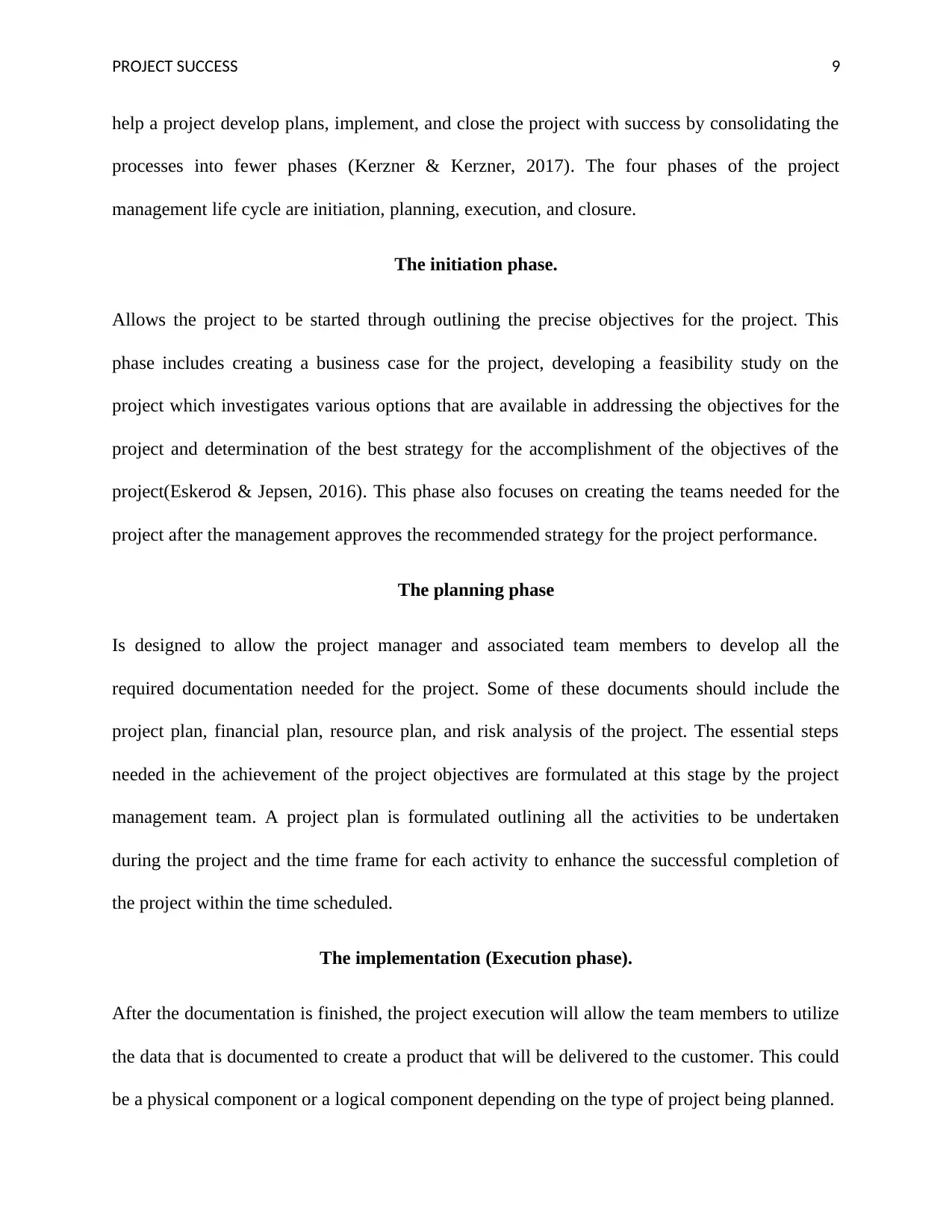
PROJECT SUCCESS 9
help a project develop plans, implement, and close the project with success by consolidating the
processes into fewer phases (Kerzner & Kerzner, 2017). The four phases of the project
management life cycle are initiation, planning, execution, and closure.
The initiation phase.
Allows the project to be started through outlining the precise objectives for the project. This
phase includes creating a business case for the project, developing a feasibility study on the
project which investigates various options that are available in addressing the objectives for the
project and determination of the best strategy for the accomplishment of the objectives of the
project(Eskerod & Jepsen, 2016). This phase also focuses on creating the teams needed for the
project after the management approves the recommended strategy for the project performance.
The planning phase
Is designed to allow the project manager and associated team members to develop all the
required documentation needed for the project. Some of these documents should include the
project plan, financial plan, resource plan, and risk analysis of the project. The essential steps
needed in the achievement of the project objectives are formulated at this stage by the project
management team. A project plan is formulated outlining all the activities to be undertaken
during the project and the time frame for each activity to enhance the successful completion of
the project within the time scheduled.
The implementation (Execution phase).
After the documentation is finished, the project execution will allow the team members to utilize
the data that is documented to create a product that will be delivered to the customer. This could
be a physical component or a logical component depending on the type of project being planned.
help a project develop plans, implement, and close the project with success by consolidating the
processes into fewer phases (Kerzner & Kerzner, 2017). The four phases of the project
management life cycle are initiation, planning, execution, and closure.
The initiation phase.
Allows the project to be started through outlining the precise objectives for the project. This
phase includes creating a business case for the project, developing a feasibility study on the
project which investigates various options that are available in addressing the objectives for the
project and determination of the best strategy for the accomplishment of the objectives of the
project(Eskerod & Jepsen, 2016). This phase also focuses on creating the teams needed for the
project after the management approves the recommended strategy for the project performance.
The planning phase
Is designed to allow the project manager and associated team members to develop all the
required documentation needed for the project. Some of these documents should include the
project plan, financial plan, resource plan, and risk analysis of the project. The essential steps
needed in the achievement of the project objectives are formulated at this stage by the project
management team. A project plan is formulated outlining all the activities to be undertaken
during the project and the time frame for each activity to enhance the successful completion of
the project within the time scheduled.
The implementation (Execution phase).
After the documentation is finished, the project execution will allow the team members to utilize
the data that is documented to create a product that will be delivered to the customer. This could
be a physical component or a logical component depending on the type of project being planned.
⊘ This is a preview!⊘
Do you want full access?
Subscribe today to unlock all pages.

Trusted by 1+ million students worldwide
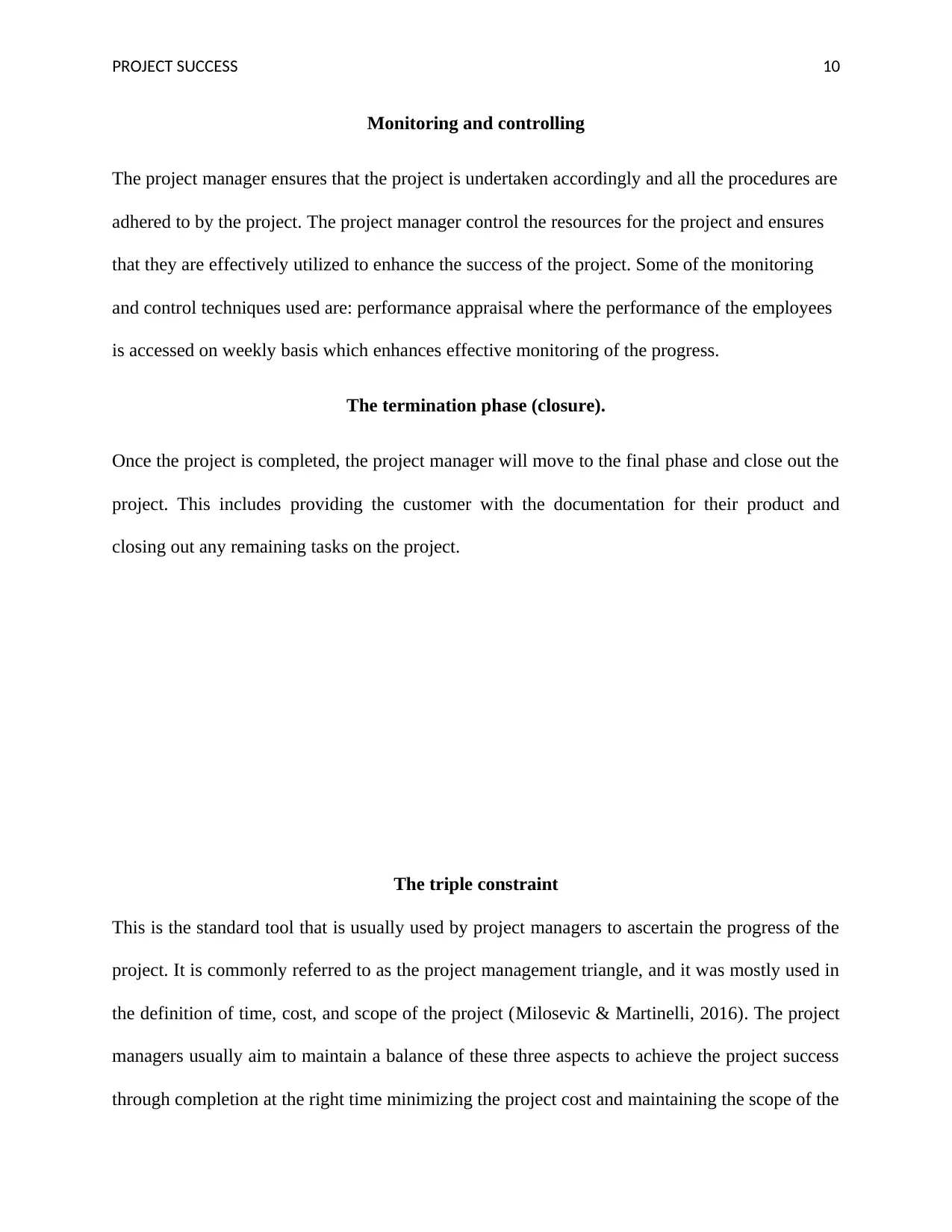
PROJECT SUCCESS 10
Monitoring and controlling
The project manager ensures that the project is undertaken accordingly and all the procedures are
adhered to by the project. The project manager control the resources for the project and ensures
that they are effectively utilized to enhance the success of the project. Some of the monitoring
and control techniques used are: performance appraisal where the performance of the employees
is accessed on weekly basis which enhances effective monitoring of the progress.
The termination phase (closure).
Once the project is completed, the project manager will move to the final phase and close out the
project. This includes providing the customer with the documentation for their product and
closing out any remaining tasks on the project.
The triple constraint
This is the standard tool that is usually used by project managers to ascertain the progress of the
project. It is commonly referred to as the project management triangle, and it was mostly used in
the definition of time, cost, and scope of the project (Milosevic & Martinelli, 2016). The project
managers usually aim to maintain a balance of these three aspects to achieve the project success
through completion at the right time minimizing the project cost and maintaining the scope of the
Monitoring and controlling
The project manager ensures that the project is undertaken accordingly and all the procedures are
adhered to by the project. The project manager control the resources for the project and ensures
that they are effectively utilized to enhance the success of the project. Some of the monitoring
and control techniques used are: performance appraisal where the performance of the employees
is accessed on weekly basis which enhances effective monitoring of the progress.
The termination phase (closure).
Once the project is completed, the project manager will move to the final phase and close out the
project. This includes providing the customer with the documentation for their product and
closing out any remaining tasks on the project.
The triple constraint
This is the standard tool that is usually used by project managers to ascertain the progress of the
project. It is commonly referred to as the project management triangle, and it was mostly used in
the definition of time, cost, and scope of the project (Milosevic & Martinelli, 2016). The project
managers usually aim to maintain a balance of these three aspects to achieve the project success
through completion at the right time minimizing the project cost and maintaining the scope of the
Paraphrase This Document
Need a fresh take? Get an instant paraphrase of this document with our AI Paraphraser
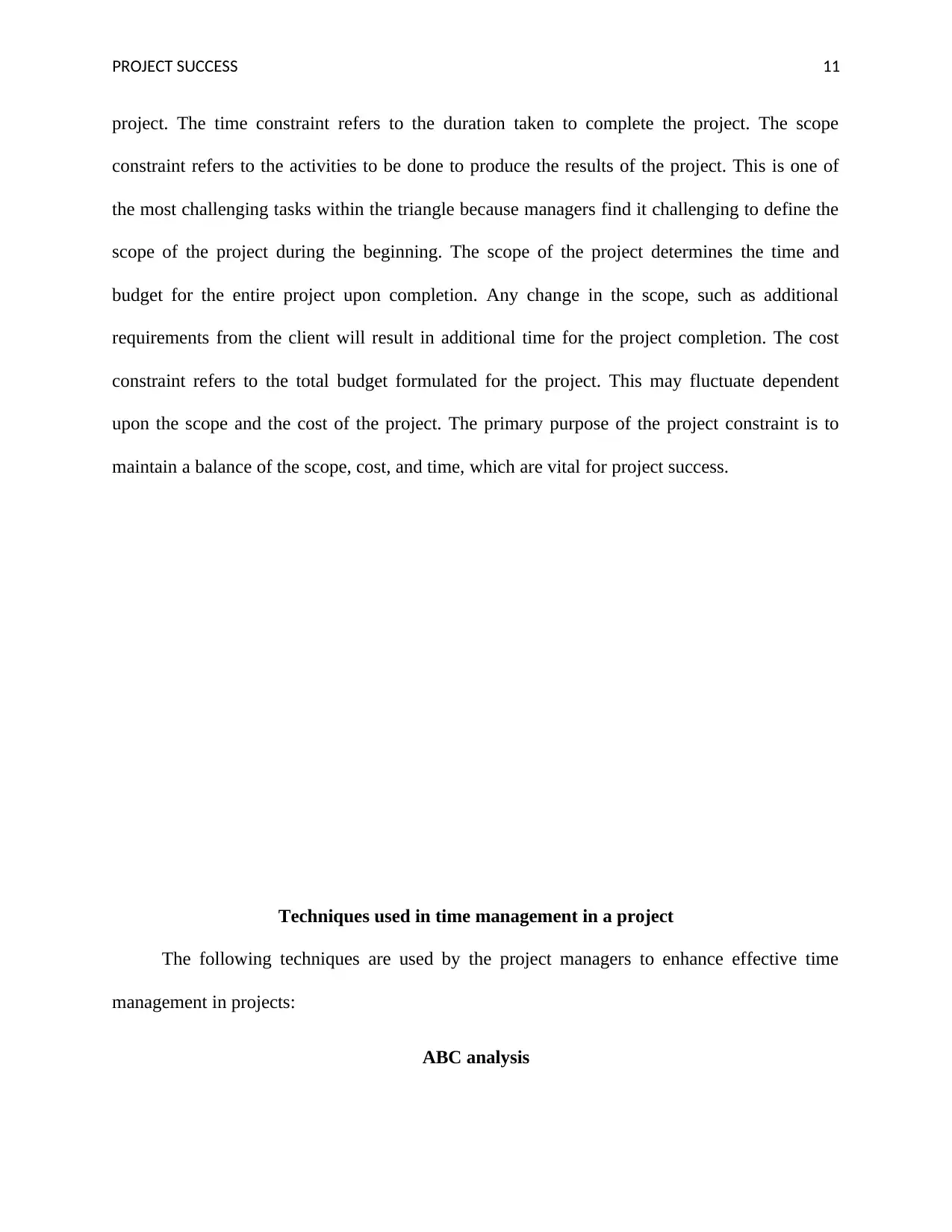
PROJECT SUCCESS 11
project. The time constraint refers to the duration taken to complete the project. The scope
constraint refers to the activities to be done to produce the results of the project. This is one of
the most challenging tasks within the triangle because managers find it challenging to define the
scope of the project during the beginning. The scope of the project determines the time and
budget for the entire project upon completion. Any change in the scope, such as additional
requirements from the client will result in additional time for the project completion. The cost
constraint refers to the total budget formulated for the project. This may fluctuate dependent
upon the scope and the cost of the project. The primary purpose of the project constraint is to
maintain a balance of the scope, cost, and time, which are vital for project success.
Techniques used in time management in a project
The following techniques are used by the project managers to enhance effective time
management in projects:
ABC analysis
project. The time constraint refers to the duration taken to complete the project. The scope
constraint refers to the activities to be done to produce the results of the project. This is one of
the most challenging tasks within the triangle because managers find it challenging to define the
scope of the project during the beginning. The scope of the project determines the time and
budget for the entire project upon completion. Any change in the scope, such as additional
requirements from the client will result in additional time for the project completion. The cost
constraint refers to the total budget formulated for the project. This may fluctuate dependent
upon the scope and the cost of the project. The primary purpose of the project constraint is to
maintain a balance of the scope, cost, and time, which are vital for project success.
Techniques used in time management in a project
The following techniques are used by the project managers to enhance effective time
management in projects:
ABC analysis
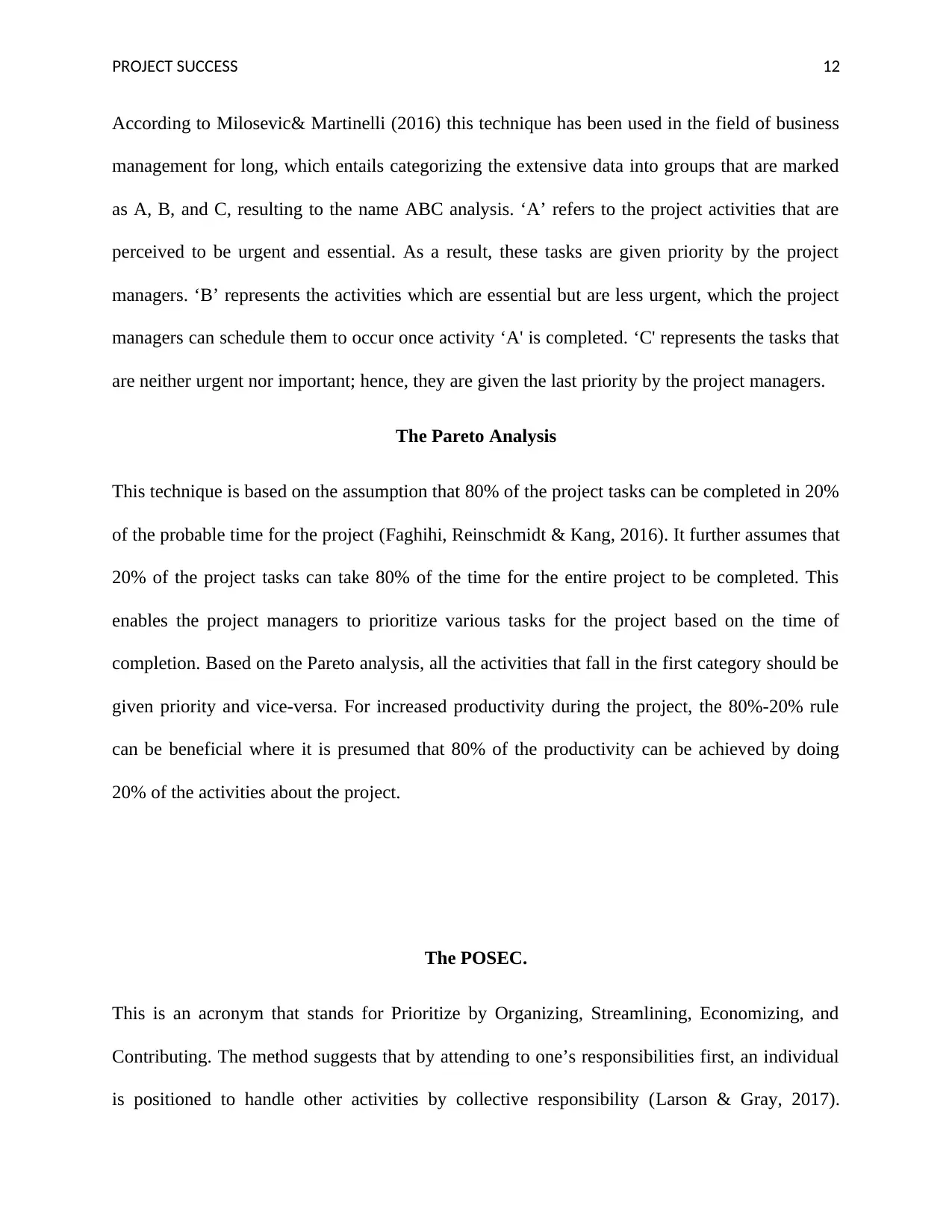
PROJECT SUCCESS 12
According to Milosevic& Martinelli (2016) this technique has been used in the field of business
management for long, which entails categorizing the extensive data into groups that are marked
as A, B, and C, resulting to the name ABC analysis. ‘A’ refers to the project activities that are
perceived to be urgent and essential. As a result, these tasks are given priority by the project
managers. ‘B’ represents the activities which are essential but are less urgent, which the project
managers can schedule them to occur once activity ‘A' is completed. ‘C' represents the tasks that
are neither urgent nor important; hence, they are given the last priority by the project managers.
The Pareto Analysis
This technique is based on the assumption that 80% of the project tasks can be completed in 20%
of the probable time for the project (Faghihi, Reinschmidt & Kang, 2016). It further assumes that
20% of the project tasks can take 80% of the time for the entire project to be completed. This
enables the project managers to prioritize various tasks for the project based on the time of
completion. Based on the Pareto analysis, all the activities that fall in the first category should be
given priority and vice-versa. For increased productivity during the project, the 80%-20% rule
can be beneficial where it is presumed that 80% of the productivity can be achieved by doing
20% of the activities about the project.
The POSEC.
This is an acronym that stands for Prioritize by Organizing, Streamlining, Economizing, and
Contributing. The method suggests that by attending to one’s responsibilities first, an individual
is positioned to handle other activities by collective responsibility (Larson & Gray, 2017).
According to Milosevic& Martinelli (2016) this technique has been used in the field of business
management for long, which entails categorizing the extensive data into groups that are marked
as A, B, and C, resulting to the name ABC analysis. ‘A’ refers to the project activities that are
perceived to be urgent and essential. As a result, these tasks are given priority by the project
managers. ‘B’ represents the activities which are essential but are less urgent, which the project
managers can schedule them to occur once activity ‘A' is completed. ‘C' represents the tasks that
are neither urgent nor important; hence, they are given the last priority by the project managers.
The Pareto Analysis
This technique is based on the assumption that 80% of the project tasks can be completed in 20%
of the probable time for the project (Faghihi, Reinschmidt & Kang, 2016). It further assumes that
20% of the project tasks can take 80% of the time for the entire project to be completed. This
enables the project managers to prioritize various tasks for the project based on the time of
completion. Based on the Pareto analysis, all the activities that fall in the first category should be
given priority and vice-versa. For increased productivity during the project, the 80%-20% rule
can be beneficial where it is presumed that 80% of the productivity can be achieved by doing
20% of the activities about the project.
The POSEC.
This is an acronym that stands for Prioritize by Organizing, Streamlining, Economizing, and
Contributing. The method suggests that by attending to one’s responsibilities first, an individual
is positioned to handle other activities by collective responsibility (Larson & Gray, 2017).
⊘ This is a preview!⊘
Do you want full access?
Subscribe today to unlock all pages.

Trusted by 1+ million students worldwide
1 out of 15
Related Documents
Your All-in-One AI-Powered Toolkit for Academic Success.
+13062052269
info@desklib.com
Available 24*7 on WhatsApp / Email
![[object Object]](/_next/static/media/star-bottom.7253800d.svg)
Unlock your academic potential
Copyright © 2020–2025 A2Z Services. All Rights Reserved. Developed and managed by ZUCOL.




